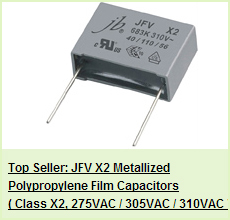2011-2-8 22:55:30
views
jb Capacitors manufactures and sells SMD Aluminum Electrolytic Capacitors. We are strong in the most two common series: 2000H at 85℃ SMD Aluminum Electrolytic Capacitors and 1000H at 105℃ SMD Aluminum Electrolytic Capacitors. Our SMD aluminum electrolytic capacitors prices are almost the best in China!
JCS - 2000H at 85℃ SMD Aluminum Electrolytic Capacitor Designed for surface mounting on high density circuit board.
Emboss carrier tape packing system is available for automatic insertion.
JCK - 1000H at 105℃ SMD Aluminum Electrolytic Capacitor
Chip type, operating with wide temperature range -40~+105℃.
Designed for surface mounting on high density circuit board.
Emboss carrier tape packing system is available for automatic insertion.
2011-2-7 22:49:33
views
Dear Valuable customer,
Good news for you :)
Most of other suppliers are on holiday for Chinese New year, but to give prompt reply and service, our sales department still work during Spring Festival.
If you have any inquiries, orders, or urgent demands, please feel free to contact our sales.
And part of our workers will work overtime for two specially busy production lines:
X2 Metallized Polypropylene Film Capacitors and Metallized Polyester Film Capacitors, if you have demands, hope we can give you fast support.
Our products catalogue: http://www.jbcapacitors.com/products.html
Welcome you to contact our sales team, our sales will feel very warm because of you ^_^.
2011-1-29 21:27:56
views
Round Feed Through capacitors, in a skin tight plastic wrap with solderable ends (Style Q). The hole in the center of the capacitor is either a Teflon Tube, Paper Tube or Phenolic Tube ranging in sizes from just a wire to a large threaded stud to fit through. The majority of Feed Throughs are custom made to exact customer requirements. They are very popular in filter applications.
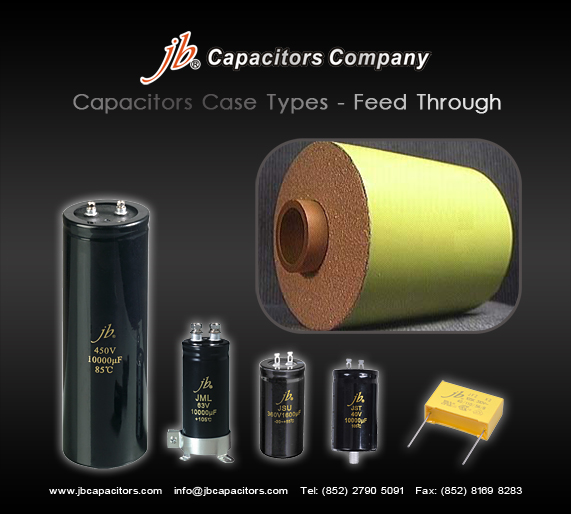
2011-1-28 21:22:28
views
jb Capacitors are encased in a molded epoxy/plastic shell with epoxy fill. Available in Axial Leaded, Rectangular (Style E); Radial Leaded, Rectangular (Style F); and Axial Leaded, Round (Style T).

2011-1-27 21:18:59
views
Capacitors are wrapped in a skin tight plastic tape and then filled with epoxy on the ends. The most economical of the packaging methods. Available in Axial Leaded, Oval (Style W); Axial Leaded, Round (Style R); Radial Leaded, Oval (Style V); and Radial Leaded, Round (Style U). Special terminal configurations and sizes are also available.
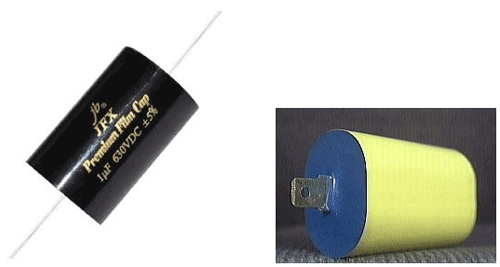
2011-1-26 16:38:23
views
The flatband diagram is by far the easiest energy band diagram. The term flatband refers to fact that the energy band diagram of the semiconductor is flat, which implies that no charge exists in the semiconductor. The flatband diagram of an aluminum-silicon dioxide-silicon MOS structure is shown in Figure 6.2.4. Note that a voltage, VFB, must be applied to obtain this flat band diagram. Indicated on the figure is also the work function of the aluminum gate, FM, the electron affinity of the oxide, coxide, and that of silicon, c, as well as the bandgap energy of silicon, Eg. The bandgap energy of the oxide is quoted in the literature to be between 8 and 9 electron volt. The reader should also realize that the oxide is an amorphous material and the use of semiconductor parameters for such material can justifiably be questioned.
The flatband voltage is obtained when the applied gate voltage equals the workfunction difference between the gate metal and the semiconductor. If there is a fixed charge in the oxide and/or at the oxide-silicon interface, the expression for the flatband voltage must be modified accordingly.
Learn more about jb capacitors company:http://www.jbcapacitors.com/
.jpg)
Figure: Flatband energy diagram of a metal-oxide-semiconductor (MOS) structure consisting of an aluminum metal, silicon dioxide and silicon.
2011-1-25 16:27:51
views
The energy band diagram of an n-MOS capacitor biased in inversion is shown in below Figure. The oxide is modeled as a semiconductor with a very large bandgap and blocks any flow of carriers between the semiconductor and the gate metal. The band bending in the semiconductor is consistent with the presence of a depletion layer. At the semiconductor-oxide interface, the Fermi energy is close to the conduction band edge as expected when a high density of electrons is present. The semiconductor remains in thermal equilibrium even when a voltage is applied to the gate. The presence of an electric field does not automatically lead to a non-equilibrium condition, as was also the case for a p-n diode with zero bias.
For more products information please check: http://www.jbcapacitors.com/
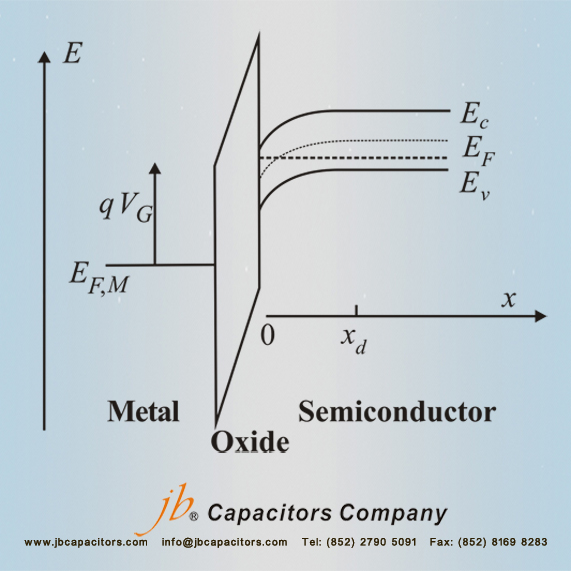
2011-1-24 13:22:22
views
The MOS capacitor consists of a Metal-Oxide-Semiconductor structure as illustrated by Figure 1. Shown is the semiconductor substrate with a thin oxide layer and a top metal contact, referred to as the gate. A second metal layer forms an Ohmic contact to the back of the semiconductor and is called the bulk contact. The structure shown has a p-type substrate. This will refer to as an n-type MOS or nMOS capacitor since the inversion layer - as discussed in section 2 - contains electrons.

To understand the different bias modes of an MOS capacitor we now consider three different bias voltages. One below the flatband voltage, VFB, a second between the flatband voltage and the threshold voltage, VT, and finally one larger than the threshold voltage. These bias regimes are called the accumulation, depletion and inversion mode of operation. These three modes as well as the charge distributions associated with each of them are shown in Figure 2.
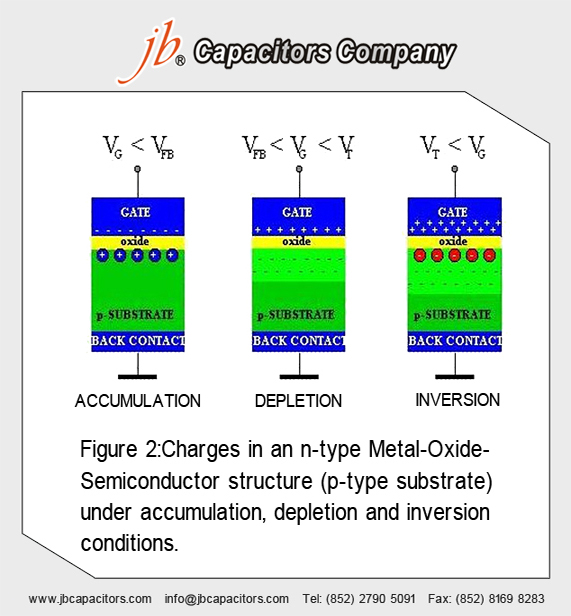
Accumulation occurs typically for negative voltages where the negative charge on the gate attracts holes from the substrate to the oxide-semiconductor interface. Depletion occurs for positive voltages. The positive charge on the gate pushes the mobile holes into the substrate. Therefore, the semiconductor is depleted of mobile carriers at the interface and a negative charge, due to the ionized acceptor ions, is left in the space charge region. The voltage separating the accumulation and depletion regime is referred to as the flatband voltage, VFB. Inversion occurs at voltages beyond the threshold voltage. In inversion, there exists a negatively charged inversion layer at the oxide-semiconductor interface in addition to the depletion-layer. This inversion layer is due to the minority carriers that are attracted to the interface by the positive gate voltage.
2011-1-24 13:18:52
views
'SMD' means Surface Mount Device. SMDs are components with small pads instead of leads for their contacts. They are designed for soldering by machine onto specially designed PCBs and are not suitable for educational or hobby circuits constructed on breadboard or stripboard.
2011-1-21 2:4:52
views
[2]-3 Electrolyte
Aluminum electrolytic capacitors are made by layering the electrolytic paper between the anode and cathode foils, and then coiling the result. The process of preparing an electrode facing the etched anode foil surface is extremely difficult. Therefore, the opposing electrode is created by filling the structure with an electrolyte. Due to this process, the electrolyte essentially functions as the cathode. The basic functional requirements for the electrolyte are as follows:
- (1) Chemically stable when it comes in contact with materials used in the anode, cathode, and electrolytic paper.
- (2) Easily wets the surfaces of the electrode.
- (3) Electrically conductive.
- (4) Has the chemical ability to protect the anode oxide thin film and compensate for any weaknesses therein.
- (5) Low volatility even at high temperatures.
- (6) Long-term stability and characteristics that take into consideration such things as toxicity.









